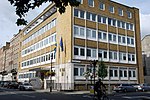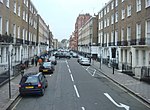Embassy of Switzerland, London
Buildings and structures in the City of WestminsterDiplomatic missions in LondonDiplomatic missions of SwitzerlandGovernment stubsLondon building and structure stubs ... and 3 more
MaryleboneSwitzerland stubsSwitzerland–United Kingdom relations

The Embassy of Switzerland (German: Schweizerische Botschaft im Vereinigten Königreich, French: Ambassade de Suisse au Royaume-Uni, Italian: Ambasciata di Svizzera nel Regno Unito) in London is the diplomatic mission of Switzerland in the United Kingdom. It consists of a large nineteenth-century building with a modern addition and is located halfway between Montagu Square and Bryanston Square. There is a commemorative stone at the entrance to the embassy marking its rebuilding in 1970.
Excerpt from the Wikipedia article Embassy of Switzerland, London (License: CC BY-SA 3.0, Authors, Images).Embassy of Switzerland, London
Montagu Place, London Marylebone
Geographical coordinates (GPS) Address External links Nearby Places Show on map
Geographical coordinates (GPS)
| Latitude | Longitude |
|---|---|
| N 51.5185 ° | E -0.1608 ° |
Address
Embassy of Switzerland (Swiss Embassy)
Montagu Place 16-18
W1H 2BQ London, Marylebone
England, United Kingdom
Open on Google Maps











